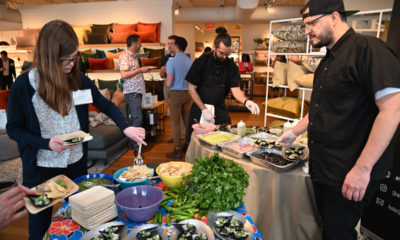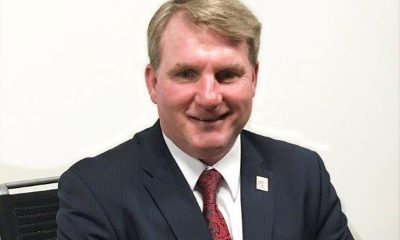District of Columbia
Shooting of gay man highlights concern over rising D.C. gun violence
‘A sense of growing lawlessness, increasing crime’
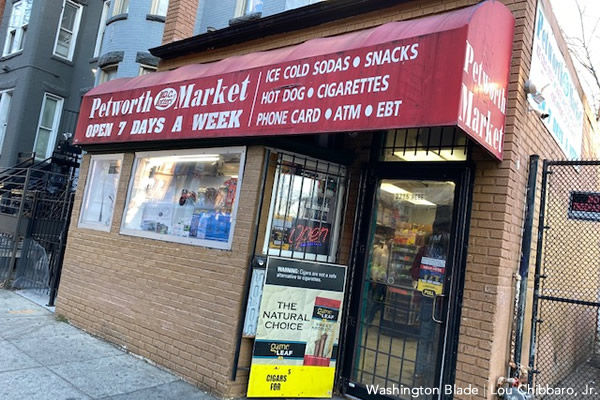
A gay man was shot twice in the hip and upper leg on Saturday morning, Dec. 11, while standing in front of a store next to the Georgia Avenue-Petworth Metro station in a development that his boyfriend says makes him yet another victim of an alarming rise in gun violence in the nation’s capital.
A D.C. police incident report says Larry Darnell Henderson, 36, was “hit twice in the lower extremities” by shots fired by an unidentified male suspect who fired nine shots into a crowd where Henderson was standing on Georgia Avenue, N.W., just before 10 a.m. on Dec. 11.
“Suspect 1 fled the scene northbound on the 3700 block of Georgia Ave. N.W., then turning eastbound into the 6700 block of Quincy St., N.W. where he was last seen,” the police report says.
Kevin McDonnell, who said he and Henderson are a couple, told the Blade that Henderson told him the male shooter initially pointed his gun at Henderson’s groin, prompting Henderson to turn his body around, which resulted in his being struck by bullets in the hip and leg.
According to McDonnell, Henderson told him the shooter did not say anything and did not attempt to rob him. But because the two men frequently patronize the stores and shops surrounding that Metro station and sometimes exhibit affection toward one another, McDonnell said he believes the shooter may have perceived Henderson to be a partner in a gay relationship and targeted him for a hate crime.
“It’s no accident that that guy pointed his gun at his genitalia,” McDonnell said. “And had LD not pivoted it would be a different story,” said McDonnell, who refers to Henderson by his nickname LD.
The police report specifically says the incident is not listed as a suspected hate crime. McDonnell disputes that designation.
When asked by the Blade if police investigators were looking for a possible video of the shooting incident from nearby surveillance cameras, a police spokesperson said if a photo of the suspect is obtained from a video camera and if police seek the public’s help in identifying and locating the suspect “we will release it.”
McDonnell said Henderson was taken by ambulance to MedStar Washington Hospital Center, where he underwent surgery. He remained at the hospital under treatment as of late Tuesday.
LGBTQ activists, meanwhile, have said they are not aware of any information to indicate that LGBTQ people are being singled out for gun violence or other types of crime to a degree greater than the general public.
A D.C. police spokesperson and the supervisor of the department’s LGBT Liaison Unit, Sgt. Nicole Brown, didn’t immediately respond to a message from the Blade asking whether officers assigned to the LGBT Liaison Unit have noticed an increase in crimes against LGBTQ people in the District during the past two years compared to previous years.
A police source familiar with the LGBT Liaison Unit, who spoke on condition of not being identified because the source was not authorized to speak to the media, said there was no “clear indication that LGBT people are being targeted any more than anyone else.”
D.C. police statistics for hate crimes posted on the police website show that for 2021, as of Sept. 30, there were a total of 29 reported hate crimes based on the victim’s sexual orientation and eight hate crimes reported based on the victim’s gender identity or expression.
Those figures compare to a total of 38 sexual orientation or anti-gay hate crimes reported in the full year of 2020 and 60 in 2019. The police data show that in 2020 there were 27 reported hate crimes based on the victim’s gender identity or status as a transgender person and the same number of 27 for that category reported in 2019.
Law enforcement observers have pointed out that the rise in violent crime in most of the nation’s large cities, including D.C., has occurred during the COVID pandemic and the COVID-related public health restrictions placed on many businesses and citizens across the country.
D.C. police data show that there was a 19 percent increase in homicides in the District in 2020 compared to 2019 – a jump from 166 to 198. As of Dec. 14, of this year, the D.C. police data show homicides rose so far in 2021 by 9 percent to a total of 212 cases as of Dec. 14.
This year’s homicide total of 212 as of Dec. 14 marked the first time the number of murders in the city has surpassed 200 since 2003, a development that has alarmed city officials and prompted D.C. Mayor Muriel Bowser last week to announce the city will expand its violence prevention and mitigation programs. Earlier this year, the mayor declared gun violence in the city a “public health crisis.”
As of that same Dec. 14, 2021, date, the D.C. police data show the crime of assault with a dangerous weapon rose by 3 percent over 2020 – from 1,581 to 1,605, robberies rose by 1 percent – 1,913 to 1,930, and the combined number of “violent crime” rose by 2 percent over 2020 from 3,855 to 3,919.
The 2021 data show that the number of burglaries declined by 4 percent so far in 2021 compared to 2020 from 1,136 to 1,094. The number of motor vehicle thefts rose by 9 percent from 3,068 in 2020 to 3,348 as of Dec. 14, 2021. The crime of “theft from auto” rose by 5 percent so far this year, from 7,897 to 8,307.
And the crime listed by D.C. police as “Theft/Other,” which is the second highest category of crime in the city, remained statistically the same but rose slightly from 10,409 in 2020 to 10,430 in 2021.
The police data show that the combined total of “property crime” in the city rose by 3 percent from 22,523 in 2020 to 23,182 as of Dec. 14, 2021.
The combined total of all instances of crime, the police data show, rose by 3 percent from 26,378 to 27,101 in 2021.
Although D.C.’s overall crime rate has not increased as much as it has in other cities, several high-profile incidents in parts of the city not accustomed to the shootings that residents of other parts of the city say they are accustomed to have alarmed businesses and nearby residents.
In July, two men were shot and wounded outside the popular strip of restaurants on 14th Street, N.W., where offices for Whitman-Walker Health are located and close to the Washington Blade’s former office. A short time later, a shooting outside Washington Nationals Stadium prompted fans inside the stadium to duck for cover and prompted demands for police and the city to do more to address gun violence.
The two high-profile shootings also drew attention to disagreements between Bowser and several members of the D.C. Council over whether or how much the fiscal year 2022 budget for the police department should be increased. Bowser and many community activists, including those in Wards 7 and 8, where the murder rate is highest, expressed concern that the number of police officers in the city is currently the lowest it has been in nearly 20 years due to retirements and attrition.
The Council in August voted to raise the police budget by $5 million, a little less than half of the $11 million that Bowser requested. The mayor has said the additional funds were needed to hire more officers to address the gun violence “crisis.”
Representatives of many of the city’s nightlife businesses, including restaurants and bars, have also expressed concern that legislation approved by the D.C. Council in recent years to place restrictions on how police make arrests of juveniles and people suffering from mental health problems have resulted in small businesses receiving less police protection against crimes targeting their customers and employees.
One law that some have objected to is the Neighborhood Engagement Achieves Results Amendment, or NEAR Act, of 2016. The law, among other things, requires that D.C. police coordinate with the city’s Department of Behavioral Health and Department of Human Services to arrange for civilian mental health clinicians and outreach specialists to join police officers in responding to crimes or disturbances caused by individuals identified as having mental illness, being homeless, or having substance abuse issues.
Although those raising concerns over the NEAR Act say they fully support providing mental health services for people who need those services, they say police in some cases have declined to respond to calls for “less serious” crimes such as “snatch-and-grab” purse and cell phone snatchings from people seated in outdoor dining areas at restaurants.
Some of the businesses have said police have expressed reluctance to respond if the suspected perpetrator has a mental health problem during evening hours when the civilian mental health experts from the Department of Behavioral Health or other city agencies are not working evening hours.
“A sense of growing lawlessness, increasing crime, and random violence is a much-discussed concern among local small business restaurant, bar, and retail store operators and workers throughout the city,” said Mark Lee, coordinator of the D.C. Nightlife Council, a local trade association representing nightlife, hospitality, and entertainment businesses in D.C.
Lee said representatives of these businesses have met recently with D.C. Council members and D.C. Police Chief Robert Contee to inform them that safety concerns by employees have begun to harm businesses and negatively impact commercial sections of the city.
“MPD leadership and rank-and-file officers, I think it’s fair to say, are as frustrated as many city residents and local enterprises have become about a D.C. Council majority that pretends it is reassigning parts of public safety and law enforcement to other government entities that are understaffed, undertrained, and largely unavailable to respond to incidents and problems,” Lee said.
He noted that because the D.C. police force is the smallest it has been in 20 years, despite population increases, “officers are stretched thin working overtime shifts.”
D.C. Council member Robert White (D-At-Large), who is running for mayor in the 2022 Democratic primary, is among the Council members who have said addressing the underlying causes of crime in the city is the only way the city can succeed in ending gun violence and other serious crimes.
“The reality is unless we start to solve these underlying issues more, crime is going to go up,” White told the Blade at a holiday event sponsored by the LGBTQ group Capital Stonewall Democrats on Monday night. “But also, once people are incarcerated, if we rehabilitate them better, crime is going to go down,” White said.
“So, being a police officer is an incredibly difficult job,” he said. “And I guess they believe – some believe – that if we lock up more people for longer periods of time, that’s going to make us safe,” White said. “And I think that fundamentally isn’t true. There has to be consequences when people commit crimes. But we can do a better job rehabilitating people,” he said.
“We can do a better job of getting to the people before they get engaged in crime. And we can do a better job of restoring the relationship between communities and the police,” White said.
Bowser and city officials working in her administration have said both approaches are needed to address the gun violence problem, including at this time the hiring of more police officers. On Dec. 9, the mayor announced plans to significantly increase the city’s ongoing violence prevention and interruption programs. Among other things, Bowser said the city will award $1.1 million in grants to community-based organizations working on violence interruption programs, especially those targeting young people.
Del McFadden, director of the D.C.Office of Neighborhood Safety and Engagement, which coordinates violence prevention efforts, said the number of “interrupters” will increase from 30 to 80. He said their work would expand to more neighborhoods, including Shaw in Ward 2, Congress Park in Ward 8, and Edgewood in Ward 5 for a total of 25 “priority” neighborhoods where gun violence has occurred.
District of Columbia
Catching up with the asexuals and aromantics of D.C.
Exploring identity and finding community
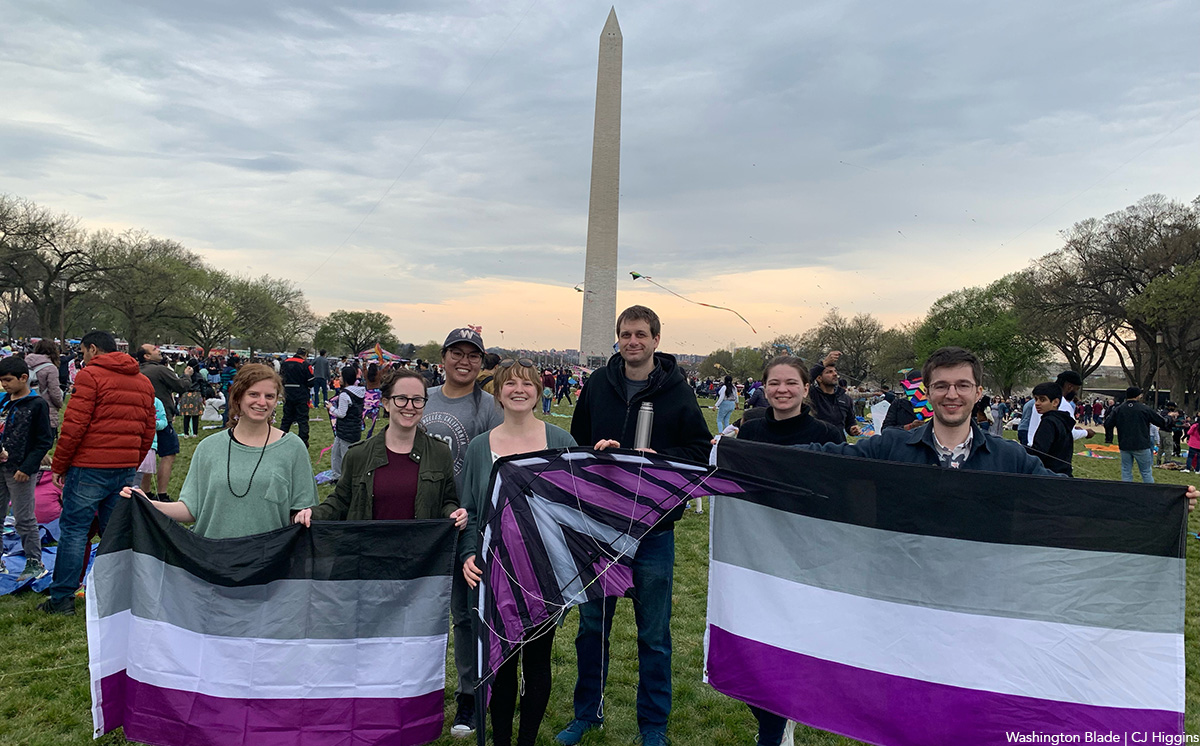
There was enough commotion in the sky at the Blossom Kite Festival that bees might have been pollinating the Washington Monument. I despaired of quickly finding the Asexuals and Aromantics of the Mid-Atlantic—I couldn’t make out a single asexual flag among the kites up above. I thought to myself that if it had been the Homosexuals of the Mid-Atlantic I would’ve had my gaydar to rely on. Was there even such a thing as ace-dar?
As it turned out, the asexual kite the group had meant to fly was a little too pesky to pilot. “Have you ever used a stunt kite?” Bonnie, the event organizer asked me. “I bought one. It looked really cool. But I can’t make it work.” She sighed. “I can’t get the thing six feet off the ground.” The group hardly seemed to care. There was caramel popcorn and cookies, board games and head massages, a game of charades with more than its fair share of Pokémon. The kites up above might as well have been a coincidental sideshow. Nearly two dozen folks filtered in and out of the picnic throughout the course of the day.
But I counted myself lucky that Bonnie picked me out of the crowd. If there’s such a thing as ace-dar, it eludes asexuals too. The online forum for all matters asexual, AVEN, or the Asexual Visibility and Education Network, is filled with laments: “I don’t think it’s possible.” “Dude, I wish I had an ace-dar.” “If it exists, I don’t have it.” “I think this is just like a broken clock is right twice a day type thing.” What seems to be a more common experience is meeting someone you just click with—only to find out later that they’re asexual. A few of the folks I met described how close childhood friends of theirs likewise came out in adulthood, a phenomenon that will be familiar to many queer people. But it is all the more astounding for asexuals to find each other this way, given that asexual people constitute 1.7% of sexual minorities in America, and so merely .1% of the population at large.
To help other asexuals identify you out in the world, some folks wear a black ring on their middle finger, much as an earring on the right ear used to signify homosexuality in a less welcoming era. The only problem? The swinger community—with its definite non-asexuality—has also adopted the signal. “It’s still a thing,” said Emily Karp. “So some people wear their ace rings just to the ace meet-ups.” Karp has been the primary coordinator for the Asexuals and Aromantics of the Mid-Atlantic (AAMA) since 2021, and a member of the meet-up for a decade. She clicked with the group immediately. After showing up for a Fourth of July potluck in the mid-afternoon, she ended up staying past midnight. “We played Cards against Humanity, which was a very, very fun thing to do. It’s funny in a way that’s different than if we were playing with people that weren’t ace. Some of the cards are implying, like, the person would be motivated by sex in a way that’s absurd, because we know they aren’t.”
Where so many social organizations withered during the pandemic, the AAMA flourished. Today, it boasts almost 2,000 members on meetup.com. Karp hypothesized that all the social isolation gave people copious time to reflect on themselves, and that the ease of meeting up online made it convenient as a way for people to explore their sexual identity and find community. Online events continue to make up about a third of the group’s meet-ups. The format allows people to participate who live farther out from D.C. And it allows people to participate at their preferred level of comfort: while many people participate much as they would at an in-person event, some prefer to watch anonymously, video feed off. Others prefer to participate in the chat box, though not in spoken conversation.
A recent online event was organized for a discussion of Rhaina Cohen’s book, “The Other Significant Others,” published in February. Cohen’s book discusses friendship as an alternative model for “significant others,” apart from the romantic model that is presupposed to be both the center and goal of people’s lives. The AAMA group received the book with enthusiasm. “It literally re-wired my brain,” as one person put it. People discussed the importance of friendship to their lives, and their difficulties in a world that de-prioritized friendship. “I can break up with a friend over text, and we don’t owe each other a conversation,” one said. But there was some disagreement when it came to the book’s discussion of romantic relationships. “It relegates ace relationships to the ‘friend’ or ‘platonic’ category, to the normie-reader,” one person wrote in the chat. “Our whole ace point is that we can have equivalent life relationships to allo people, simply without sex.” (“Allo” is shorthand for allosexual or alloromantic, people who do experience sexual or romantic attraction.)
The folks of the AAMA do not share a consensus on the importance of romantic relationships to their lives. Some asexuals identify as aromantic, some don’t. And some aromantics don’t identify as asexual, either. The “Aromantic” in the title of the group is a relatively recent addition. In 2017, the group underwent a number of big changes. The group was marching for the first time in D.C. Pride, participating in the LGBTQ Creating Change conference, and developing a separate advocacy and activism arm. Moreover, the group had become large enough that discussions were opened up into forming separate chapters for D.C., Central Virginia, and Baltimore. During those discussions, the group leadership realized that aromantic people who also identified as allosexual didn’t really have a space to call their own. “We were thinking it would be good to probably change the name of the Meetup group,” Emily said. “But we were not 100% sure. Because [there were] like 1,000 people in the group, and they’re all aces, and it’s like, ‘Do you really want to add a non-ace person?’” The group leadership decided to err on the side of inclusion. “You know, being less gatekeep-y was better. It gave them a place to go — because there was nowhere else to go.”
The DC LGBT Center now sponsors a support group for both asexuals and aromantics, but it was formed just a short while ago, in 2022. The founder of the group originally sought out the center’s bisexual support group, since they didn’t have any resources for ace folks. “The organizer said, you know what, why don’t we just start an ace/aro group? Like, why don’t we just do it?” He laughed. “I was impressed with the turnout, the first call. It’s almost like we tapped into, like, a dam. You poke a hole in the dam, and the water just rushes out.” The group has a great deal of overlap with the AAMA, but it is often a person’s first point of contact with the asexual and aromantic community in D.C., especially since the group focuses on exploring what it means to be asexual. Someone new shows up at almost every meeting. “And I’m so grateful that I did,” one member said. “I kind of showed up and just trauma dumped, and everyone was really supportive.”
Since the ace and aro community is so small, even within the broader queer community, ace and aro folks often go unrecognized. To the chagrin of many, the White House will write up fact sheets about the LGBTQI+ community, which is odd, given that when the “I” is added to the acronym, the “A” is usually added too. OKCupid has 22 genders and 12 orientations on its dating website, but “aromantic” is not one of them — presumably because aromantic people don’t want anything out of dating. And since asexuality and aromanticism are defined by the absence of things, it can seem to others like ace and aro people are ‘missing something.’ One member of the LGBT center support group had an interesting response. “The space is filled by… whatever else!” they said. “We’re not doing a relationship ‘without that thing.’ We’re doing a full scale relationship — as it makes sense to us.”
CJ Higgins is a postdoctoral fellow with the Alexander Grass Humanities Institute at Johns Hopkins University.
District of Columbia
Bowser budget proposal calls for $5.25 million for 2025 World Pride
AIDS office among agencies facing cuts due to revenue shortfall
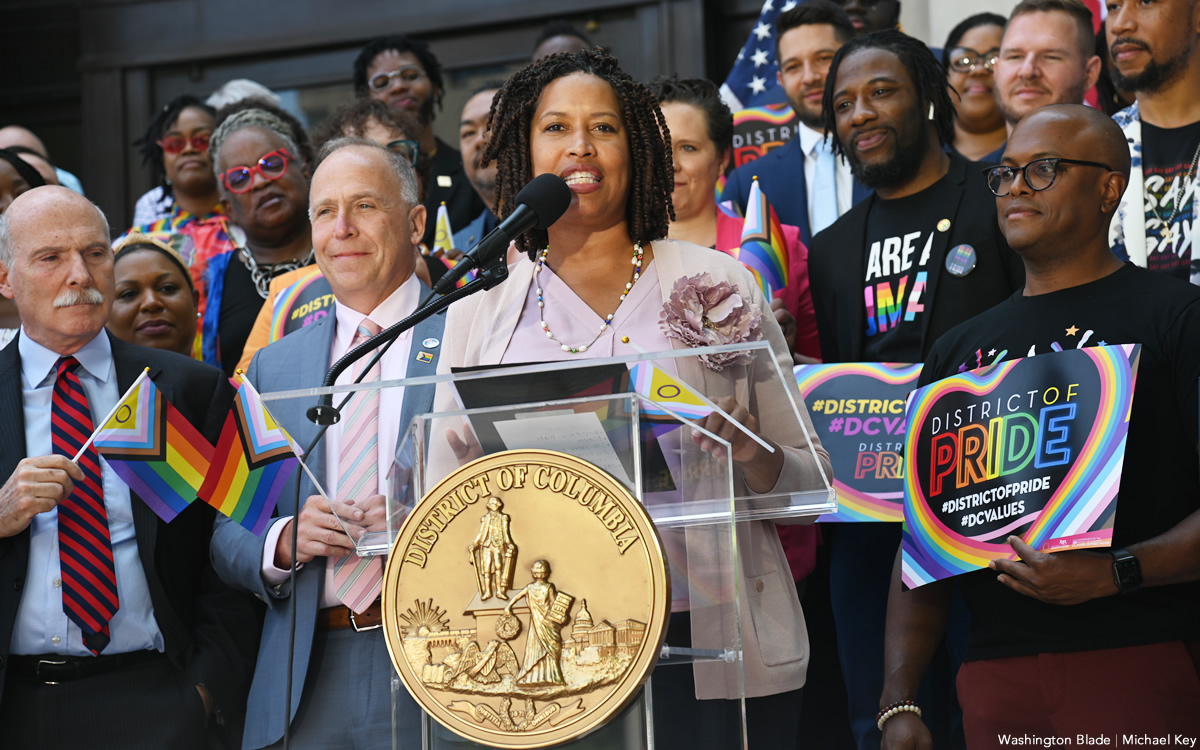
D.C. Mayor Muriel Bowser’s proposed fiscal year 2025 budget includes a request for $5.25 million in funding to support the June 2025 World Pride celebration, which D.C. will host, and which is expected to bring three million or more visitors to the city.
The mayor’s proposed budget, which she presented to the D.C. Council for approval earlier this month, also calls for a 7.6 percent increase in funding for the Mayor’s Office of LGBTQ Affairs, which amounts to an increase of $132,000 and would bring the office’s total funding to $1.7 million. The office, among other things, provides grants to local organizations that provide services to the LGBTQ community.
Among the other LGBTQ-related funding requests in the mayor’s proposed budget is a call to continue the annual funding of $600,000 to provide workforce development services for transgender and gender non-conforming city residents “experiencing homelessness and housing instability.” The budget proposal also calls for a separate allocation of $600,000 in new funding to support a new Advanced Technical Center at the Whitman-Walker Health’s Max Robinson Center in Ward 8.
Among the city agencies facing funding cuts under the mayor’s proposed budget is the HIV/AIDS, Hepatitis, Sexually Transmitted Disease, and Tuberculosis Administration, known as HAHSTA, which is an arm of the D.C. Department of Health. LGBTQ and AIDS activists have said HAHSTA plays an important role in the city’s HIV prevention and support services. Observers familiar with the agency have said it recently lost federal funding, which the city would have to decide whether to replace.
“We weren’t able to cover the loss of federal funds for HAHSTA with local funds,” Japer Bowles, director of the Mayor’s Office of LGBTQ Affairs, told the Washington Blade. “But we are working with partners to identify resources to fill those funding gaps,” Bowles said.
The total proposed budget of $21 billion that Bowser submitted to the D.C. Council includes about $500 million in proposed cuts in various city programs that the mayor said was needed to offset a projected $700 million loss in revenue due, among other things, to an end in pandemic era federal funding and commercial office vacancies also brought about by the post pandemic commercial property and office changes.
Bowser’s budget proposal also includes some tax increases limited to sales and business-related taxes, including an additional fee on hotel bookings to offset the expected revenue losses. The mayor said she chose not to propose an increase in income tax or property taxes.
Earlier this year, the D.C. LGBTQ+ Budget Coalition, which consists of several local LGBTQ advocacy organizations, submitted its own fiscal year 2025 budget proposal to both Bowser and the D.C. Council. In a 14-page letter the coalition outlined in detail a wide range of funding proposals, including housing support for LGBTQ youth and LGBTQ seniors; support for LGBTQ youth homeless services; workforce and employment services for transgender and gender non-conforming residents; and harm reduction centers to address the rise in drug overdose deaths.
Another one of the coalition’s proposals is $1.5 million in city funding for the completion of the D.C. Center for the LGBTQ Community’s new building, a former warehouse building in the city’s Shaw neighborhood that is undergoing a build out and renovation to accommodate the LGBTQ Center’s plans to move in later this year. The coalition’s budget proposal also calls for an additional $300,000 in “recurring” city funding for the LGBTQ Center in subsequent years “to support ongoing operational costs and programmatic initiatives.”
Bowles noted that Bowser authorized and approved a $1 million grant for the LGBTQ Center’s new building last year but was unable to provide additional funding requested by the budget coalition for the LGBTQ Center for fiscal year 2025.
“We’re still in this with them,” Bowles said. “We’re still looking and working with them to identify funding.”
The total amount of funding that the LGBTQ+ Budget Coalition listed in its letter to the mayor and Council associated with its requests for specific LGBTQ programs comes to $43.1 million.
Heidi Ellis, who serves as coordinator of the coalition, said the coalition succeeded in getting some of its proposals included in the mayor’s budget but couldn’t immediately provide specific amounts.
“There are a couple of areas I would argue we had wins,” Ellis told the Blade. “We were able to maintain funding across different housing services, specifically around youth services that affect folks like SMYAL and Wanda Alston.” She was referring to the LGBTQ youth services group SMYAL and the LGBTQ organization Wanda Alston Foundation, which provides housing for homeless LGBTQ youth.
“We were also able to secure funding for the transgender, gender non-conforming workforce program,” she said. “We also had funding for migrant services that we’ve been advocating for and some wins on language access,” said Ellis, referring to programs assisting LGBTQ people and others who are immigrants and aren’t fluent in speaking English.
Ellis said that although the coalition’s letter sent to the mayor and Council had funding proposals that totaled $43.1 million, she said the coalition used those numbers as examples for programs and policies that it believes would be highly beneficial to those in the LGBTQ community in need.
“I would say to distill it down to just we ask for $43 million or whatever, that’s not an accurate picture of what we’re asking for,” she said. “We’re asking for major investments around a few areas – housing, healthcare, language access. And for capital investments to make sure the D.C. Center can open,” she said. “It’s not like a narrative about the dollar amounts. It’s more like where we’re trying to go.”
The Blade couldn’t’ immediately determine how much of the coalition’s funding proposals are included in the Bowser budget. The mayor’s press secretary, Daniel Gleick, told the Blade in an email that those funding levels may not have been determined by city agencies.
“As for specific funding levels for programs that may impact the LGBTQ community, such as individual health programs through the Department of Health, it is too soon in the budget process to determine potential adjustments on individual programs run though city agencies,” Gleick said.
But Bowles said several of the programs funded in the mayor’s budget proposal that are not LGBTQ specific will be supportive of LGBTQ programs. Among them, he said, is the budget’s proposal for an increase of $350,000 in funding for senior villages operated by local nonprofit organizations that help support seniors. Asked if that type of program could help LGBTQ seniors, Bowles said, “Absolutely – that’s definitely a vehicle for LGBTQ senior services.”
He said among the programs the increased funding for the mayor’s LGBTQ Affairs office will support is its ongoing cultural competency training for D.C. government employees. He said he and other office staff members conduct the trainings about LGBTQ-related issues at city departments and agencies.
Bowser herself suggested during an April 19 press conference that local businesses, including LGBTQ businesses and organizations, could benefit from a newly launched city “Pop-Up Permit Program” that greatly shortens the time it takes to open a business in vacant storefront buildings in the downtown area.
Bowser and Nina Albert, D.C. Deputy Mayor for Planning and Economic Development, suggested the new expedited city program for approving permits to open shops and small businesses in vacant storefront spaces could come into play next year when D.C. hosts World Pride, one of the word’s largest LGBTQ events.
“While we know that all special events are important, there is an especially big one coming to Washington, D.C. next year,” Bowser said at the press conference. “And to that point, we proposed a $5.25 million investment to support World Pride 2025,” she said, adding, “It’s going to be pretty great. And so, we’re already thinking about how we can include D.C. entrepreneurs, how we’re going to include artists, how we’re going to celebrate across all eight wards of our city as well,” she said.
Among those attending the press conference were officials of D.C.’s Capital Pride Alliance, which will play a lead role in organizing World Pride 2025 events.
District of Columbia
Taste of Point returns at critical time for queer students
BIPOC scholar to speak at Room & Board event on May 2
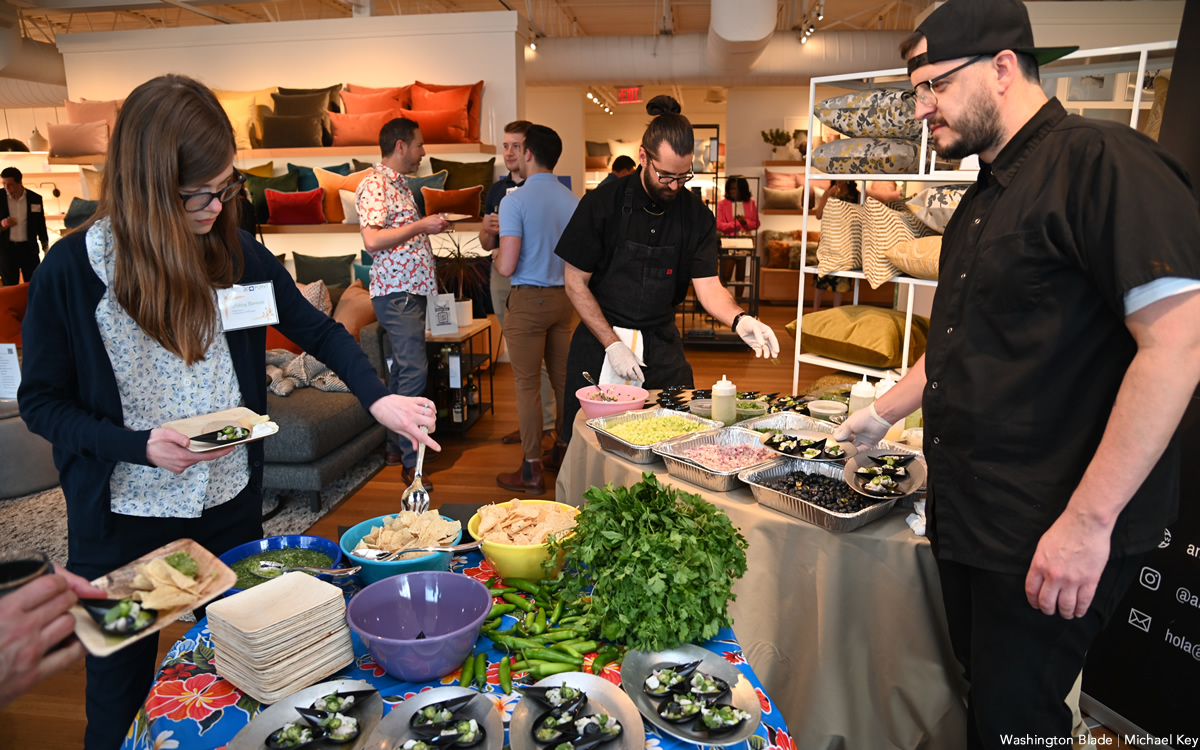
The Point Foundation will kick off May with its annual Taste of Point DC event. The event will be hosted at Room & Board on 14th Street and feature a silent auction, food tastings, a speech from a scholar, and more.
Point’s chief of staff, Kevin Wright, said that at Taste of Point, the scholars are the star of the show.
“People never come to an event to hear Point staff speak, they come to hear from the people most impacted by the program,” he said. “At its core Taste of Point is designed to center and highlight our scholars’ voices and experiences.”
This year, a Point BIPOC Scholar, Katherine Guerrero Rivera will speak at the event.
“It is a great opportunity to highlight the scholars out there on the front lines making impacts in almost every sector and job field,” Wright said.
Wright pointed out that this year especially is a pivotal time for LGBTQ students.
“In 2023, there were 20 states that passed anti-LGBTQ legislation,” he said. “By this point in [2024] we already have more.”
Wright said the impacts of those legislative attacks are far reaching and that Point is continuously monitoring the impact they have on students on the ground.
Last month, The Washington Post reported that states with anti-LGBTQ laws in place saw school hate crimes quadruple. This report came a month after a non-binary student, Nex Bennedict, died after being attacked at school.
“So, we see this as a critical moment to really step up and help students who are facing these challenges on their campus,” Wright said. “Our mission is to continue to empower our scholars to achieve their full academic and leadership potential.”
This year Point awarded nearly 600 LGBTQ students with scholarships. These include the flagship scholarship, community college scholarship and the BIPOC scholarship. When the foundation started in 2002, there were only eight scholarships awarded.
Dr. Harjant Gill is one of those scholars who said the scholarship was pivotal for him. Gill said he spent his undergraduate years creating films and doing activism for the LGBTQ community.
As a result, his academic record wasn’t stellar and although he was admitted into American University’s graduate program he had no clue how he would fund it.
Upon arrival to American he was told to apply for a Point scholarship and the rest was history.
“It ended up being the one thing that kept me going otherwise I would have dropped out,” he said. “Point was incredibly instrumental in my journey to becoming an academic and a professor.”
More than a decade later, Gill serves on the host committee for Taste of Point and is a mentor to young Point scholars. He said that he donates money yearly to Point and that when he is asked what he wants for a gift he will often tell his friends to donate too.
To attend the event on Wednesday, May 2, purchase tickets at the Point website. If you can’t attend this year’s Taste of Point DC event but would like to get involved, you can also donate online.
-

 State Department3 days ago
State Department3 days agoState Department releases annual human rights report
-

 Maryland4 days ago
Maryland4 days agoJoe Vogel campaign holds ‘Big Gay Canvass Kickoff’
-

 Politics4 days ago
Politics4 days agoSmithsonian staff concerned about future of LGBTQ programming amid GOP scrutiny
-

 District of Columbia22 hours ago
District of Columbia22 hours agoCatching up with the asexuals and aromantics of D.C.



